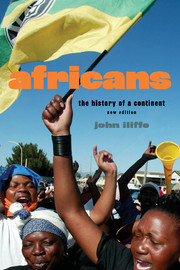Book contents
- Frontmatter
- Contents
- List of maps
- Preface to the second edition
- Africans
- 1 The frontiersmen of mankind
- 2 The emergence of food-producing communities
- 3 The impact of metals
- 4 Christianity and Islam
- 5 Colonising society in western Africa
- 6 Colonising society in eastern and southern Africa
- 7 The Atlantic slave trade
- 8 Regional diversity in the nineteenth century
- 9 Colonial invasion
- 10 Colonial change, 1918–1950
- 11 Independent Africa, 1950–1980
- 12 Industrialisation and race in South Africa, 1886–1994
- 13 In the time of AIDS
- Notes
- Further reading
- Index
- Books in the series
13 - In the time of AIDS
- Frontmatter
- Contents
- List of maps
- Preface to the second edition
- Africans
- 1 The frontiersmen of mankind
- 2 The emergence of food-producing communities
- 3 The impact of metals
- 4 Christianity and Islam
- 5 Colonising society in western Africa
- 6 Colonising society in eastern and southern Africa
- 7 The Atlantic slave trade
- 8 Regional diversity in the nineteenth century
- 9 Colonial invasion
- 10 Colonial change, 1918–1950
- 11 Independent Africa, 1950–1980
- 12 Industrialisation and race in South Africa, 1886–1994
- 13 In the time of AIDS
- Notes
- Further reading
- Index
- Books in the series
Summary
as the twenty-first century began, the african continent was experiencing both crisis and renewal. Economic decline during the 1970s had obliged governments to accept structural adjustment programmes that exposed their peoples to two decades of acute hardship before signs of recovery appeared. As impoverished governments had reduced their services, individuals and groups had drawn upon their own ingenuity to survive. One-party states had collapsed throughout tropical Africa, leaving behind both violence and greater freedom, while in the north, Islamic fundamentalism threatened surviving freedoms while giving purpose to many young lives. The rapid population growth of the late twentieth century was slowing, facilitating stabilisation and economic recovery. In its place, the AIDS epidemic had brought suffering and new forms of social dislocation, but as the new century began, even this most terrible of disasters showed the first signs of hope.
STRUCTURAL ADJUSTMENT
During the late 1970s, as postwar growth gave way to global recession, indebted African governments seeking loans from the International Monetary Fund (IMF) invited the World Bank to examine their economic situation. The Bank's response, Accelerated development in sub-Saharan Africa (1981), reversed the economic strategy of a generation. Written in the newly fashionable language of monetary economics, the report condemned state-centred development policies that had exploited farmers and destroyed agricultural exports in the interests of inefficient, corrupt, and urban-based government enterprises. The state, it proclaimed, was the obstacle rather than the agent of progress.
- Type
- Chapter
- Information
- AfricansThe History of a Continent, pp. 288 - 316Publisher: Cambridge University PressPrint publication year: 2007

